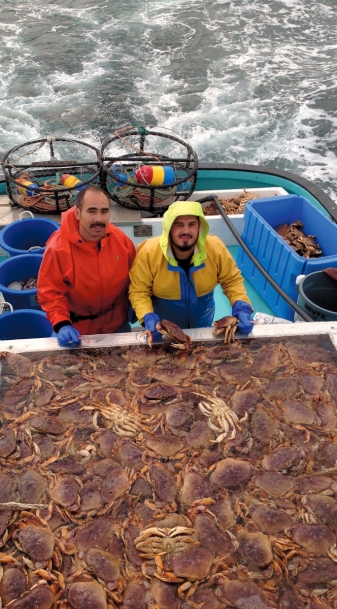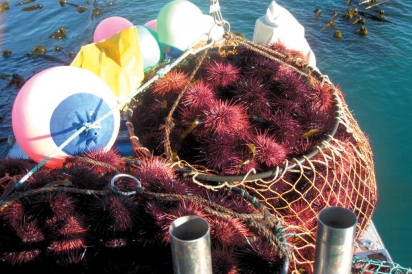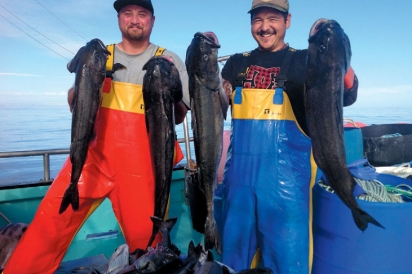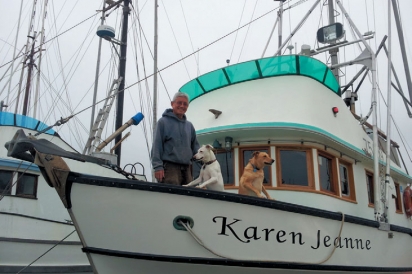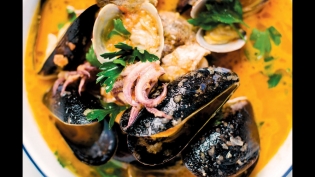Truly fresh catch
The Bodega Bay Community Fishing Association Aims to Put More (Local) Seafood on Your Plate
Nothing about fishing in Northern California is easy. Everything from climate change and drought to government regulations and consumers’ changing tastes impacts how and what seafood makes it onto your plate.
Take for example two iconic Northern California seafoods: Dungeness crab and Chinook (or king) salmon. After record high ocean temperatures and relentless algae blooms last year resulted in toxic levels of domoic acid in Dungeness crab, the opening of their harvest season was delayed from the customary November until March. The nonexistent, then greatly reduced, supply of local crab shocked the state and brought many Marin and Sonoma-based fishermen to near ruin.
Persistent drought compounds the already epically challenging environment for wild salmon, and the fishermen who make a living bringing them to our tables.
Fishermen are a hardy group by nature but no match for Mother Nature.
And even when they are successful in bringing in their catch, how do they market, then distribute, their haul to consumers after long days on the sea?
For small boat fishermen who fish in and around Sonoma County’s Bodega Bay, help with the latter comes from the Bodega Bay Fisherman’s Marketing Association (BBFMA). Founded in 1953, the association was formed to represent the interest of Bodega Bay’s fishermen in seasonal negotiations over seafood prices. For decades, the BBFMA has been a pillar of the Bodega Bay community. Funded by dues based on each member’s catch of salmon and Dungeness crab, the BBFMA has supported the local community through everything from Bodega Bay’s annual fishermen’s festival to scholarships for college-bound students, and even loans to fishermen who fall on hard times.
As federal fisheries policies have evolved since the 1950s, the mission and activities of the BBFMA needed updating and three years ago the all-fishermen board of directors of the BBFMA created a new entity called the Bodega Bay Community Fishing Association (the BBCFA). Formed in compliance with new federal law, the BBCFA is tasked with promoting the fish and seafood harvested from local waters, and hopes to make Bodega Bay a thriving hub for local commercial fishing and sales of seafood.
The BBCFA launched with two main goals: build a dock and hoist that its members could use to offload catch, and generate a larger and more robust market for that catch.
Like many fishing ports in Northern California, Bodega Bay is a small harbor where 60 to 100 small boat fisherman anchor to offload fish. “Before the CFA, the prices in Bodega were the lowest coast-wide for most fish,” said Kalla Hirschbein, an environmental and fisheries attorney who is currently working with the BBCFA.
With Hirschbein’s help, the BBCFA secured funding from the National Fish and Wildlife Foundation and created a business plan and community sustainability plan. With the funds, the BBCFA has already leased dock space at Mason’s Marina in Bodega Bay, refurbished the dock, installed a new hoist and purchased a forklift.
A local food promotion program within the U.S. Department of Agriculture is funding an effort to raise the price floor for their catch and develop a modern, sustainable distribution system to sell the seafood to the local community and area restaurants.
An unused gas station near the dock is also being transitioned into a fish market where the fishermen can sell their fish direct to local consumers, mere moments later. “The market will be completely accessible to the public,” says Hirschbein, and whole fish and fish cut to order will be available on a consistent basis.
Stan Carpenter, a long time Bodega Bay fisherman and advocate for local seafood, shared that Zach MacGowan, a former fisherman who now owns and operates a trucking company, is slated to helm the market. “Zach is a Bodega local,” said Carpenter. “He can help with the distribution and will be available for the fishermen.” And likely add an important local voice to boost the market’s awareness and distribution efforts.
Hirschbein notes that most of these pieces were in place more than a year ago, ready for the opening of the 2015–16 crab season. The domoic acid problem severely impacted Bodega Bay and surrounding communities, forcing boat captains to lay off crews or sell their gear altogether. The community’s energies were diverted as fishermen needed to fish further afield in order to pay their bills.
At the time of this writing, the new market was slated to open November 15, the same day as the expected opening of the 2016–17 commercial Dungeness crab season.
As community-supported agriculture programs have done so successfully with vegetables, fruits and other land-based products, the BBCFA and other commercial fishing groups throughout the region and nationally are working to expand the direct-to-consumer marketing of seafood. Specifically, the BBCFA is looking to the fish market to be a springboard for the development of a thriving direct marketplace for sustainable, locally harvested seafood, and to also serve as a pickup location for larger-scale distributors.
Involved from the start in developing the BBCFA, Richard “Dick” Ogg is a member of the BBCFA board and is instrumental in steering other organization projects such as the recently announced crab pot recovery program to reduce whale entanglements and clean up the ocean from fishing debris. He is eager to see the BBCFA take off as the region’s farmers’ markets have, promoting consumption of local seafood and creating a local marketplace for fishermen to sell their products. “Smaller boats are better off with this kind of program,” said Ogg. “And the community benefits from purchasing directly from the fishermen.”
For updates on the BBCFA and their market in Bodega Bay, visit http://www.facebook.com/bodegabaycommunityfish/.
REELIN’ EM IN
During my research for this article, I spoke with a few Bodega Bay-based fishet111et1 to learn the specific issues surrounding the most popular fisheries in their range.
SALMON
The plight of West Coast salmon is wel1 known. Their natural migratory rhythm stymied by dams and water diversions that provide water to most Californians, salmon’s future is also threatened by California’s persistent drought that reduces even further the water flowing in open, non-dammed waterways.
In reality, California’s “wild” salmon population is largely reliant on human intervention: support from federal and state government agencies and local commercial fishermen. You could say that the work is just undoing the damage that man has done.
Regionally this support starts with hundreds of thousands of salmon being spawned in a Califomia Department of Fish and Wildlife-operated hatchery near Oroville. Raising them to maturity there would be “farming” the fish, however, so then what? “We used to turn them loose near the hatchery,” said Stan Carpenter, “but most of them were lost due to pumping in the Delta,” along with natural causes. So commercial fishermen created a state-managed dedicated salmon restoration project, funded by annual salmon fishing permit fees, that supports innovative efforts to increase the salmon population. This includes paying to have the 12- to 18-month old smolts trucked from the hatchery to Vallejo, bypassing the pumps and increasing their survival rate tenfold. “We still lose about 100% through the Golden Gate,” said Carpenter,
Locally, there’s another safety net-literally. Local fishermen have recently built a salmon net pen in Bodega Bay. Net pen programs, overseen by the California Department of Fish and Wildlife, are also in place in key fishing harbors such as Half Moon Bay and Moss Landing, and Santa Cruz is adding a program this year. At Bodega Bay, the plan is to truck in 250,000 sma Its, each tagged with a coded wire to track the fish. The smolts will be moved from the trucks to the pen, which is floating in open water. Once the fish have acclimated to the harbor water, a boat hauls the net pen to the open sea and releases the fish into the wild.
Despite all of this intervention, all fishermen-commercial and sport-must still rely on ocean conditions to provide enough krill for the salmon to thrive once they reach the ocean, “We need the northwest winds to get the upwelling [which brings cold water up from the bottom of the ocean]. If we don’t get that, we don’t get the krill,” said Carpenter. And no salmon.
UNI
like krill for salmon, red sea urchin-also known as uni-need an abundance of kelp to thrive. The warm waters of recent years have significantly reduced the kelp forests off Marin and Sonoma.
“It’s really a combination of things,” said Eric Owen, who has fished commercially for uni since 1986. The widely applauded resurgence of sea otter populations has had a negative effect on uni, one of the animals’ main foods. “The urchin’s other main predator, sea stars, had a wasting disease a few years ago which allowed purple urchins [which are not commercially fished] to take over sea structures. That, and a lack of a hard northwest wind that reduced upwelling, increased water temperature and caused a reduction in kelp populations. As a result. uni are on a down cycle,” he said.
In good uni years, Owen spends four to six hours a day underwater breathing through a “hookah system,” with air lines coming from his boat, hand-harvesting 5,000 to 7,000 pounds of red urchin a day. Prolific uni spawn several times before they reach a minimum harvest size of 3h inches and they are labeled a “good alternative” by Monterey Bay Aquarium’s Seafood Watch. Owen says he is excited about the near future for the local uni harvest (Currently uni may be fished year round, but the water does need to be clear.) “We are now on the lower end of the cycle, but if the kelp canopy grows sufficiently, I can harvest uni for the next one to two years.”
Owen says he has been fishing for salmon and crab while the kelp recovers, bringing with it an increase in the uni population.
ALBACORE AND BLACK COD
Like many small-boat fishermen, Dick Ogg constantly adapts his fishing according to conditions and availability.
Ogg has fished albacore tuna for nearly 20 years. “As long as the water is clean, albacore should be plentiful,” said Ogg, The albacore season runs from July through October, but is most plentiful in July and August.
There are currently no seasonal restrictions on black cod, so when crab and salmon are out of season, or when a fishery is otherwise impacted (such as the much-delayed opening of crab season last winter), more black cod is likely to start showing up in our local markets.


